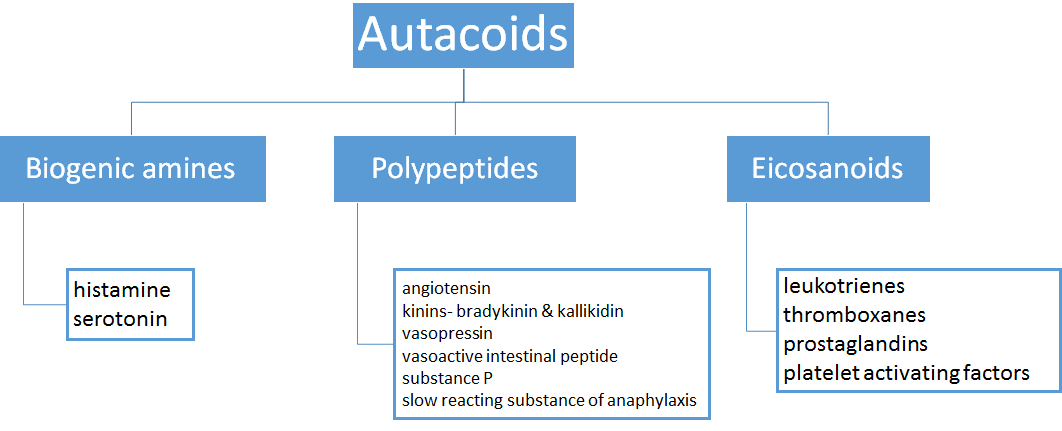Other autacoids

The pharmacology and clinical impact of histamine and serotonin have been described above. This section will focus on other clinically important autacoid molecules.
Autacoids release can be triggered by agents including chemical and immune irritants, UV light, bacterial toxins and physical trauma.
Whilst histamine mediates the wheal, flare and redness reactions, the prostaglandins mediate pain.
Autacoids antagonists include the antihistamines (see the Histamine section above), serotonin antagonists (see the Serotonin section above) and prostaglandin synthesis inhibitors (typically aspirin, paracetamol and the NSAIDs- see the Cyclooxygenase (COX) inhibitors section of the Enzymes module).
Eicosanoids
These are lipid derived molecules synthesized from arachadonic acid (AA). AA is liberated from membrane phospholipids by the action of phospholipase A2 (PLA2). The enzymes involved in the turnover of the eicosanoids can be viewed here.
Therapeutic uses of prostaglandins
PGE1 (alprostadil) is administered by intracavernosal injection to both diagnose and treat erectile dysfunction.
The synthetic prostaglandin analogue misoprostol has antisecretory and protective properties, promoting healing of gastric and duodenal ulcers. Used to treat benign gastric and duodenal ulceration and NSAID-associated ulceration. Misoprostol also acts as a potent uterine stimulant, and can be used off-label for termination of pregnancy (following mifepristone administration).
Leukotrienes
As their name suggests these agents are produced by leukocytes, but are also found in other immune cells. Leukotrienes act in a paracrine or autocrine manner to regulate immune responses and production is typically accompanied by secretion of the other inflammatory mediators, histamine and prostaglandins. Leukotrienes are divided in to two groups: the cysteinyl leukotrienes (LTC4, LTD4, LTE4, LTF4) which contain a cysteine residue in their structure, and the others which don't have this cysteine residue (LTB4, LTG4 and LTB5).
Hyper-production of LTD4 is an important cause of airway inflammation in asthma and allergic rhinitis, and can induce anaphylactic shock. LTD4 is an agonist of the GPCRs CysLT1 and CysLT2. This action stimulates proinflammatory activities such as endothelial cell adherence and chemokine production by mast cells. The Leukotriene receptor antagonists montelukast (non-selective) and zafirlukast (CysLT1 selective), block the effects of cysteinyl leukotrienes in the airways. They are effective in asthma when used alone or with an inhaled corticosteroid. Leukotriene receptor antagonists may be of benefit in exercise-induced asthma and in patients with concomitant rhinitis.Tthey are less effective in patients with severe asthma who are also receiving high doses of other drugs.
Platelet activating factor (PAF)
PAF is synthesized by host defense cells (e.g. platelets, neutrophils, monocytes and macrophages) at constant low levels and in larger amounts by activated inflammatory cells (e.g. mast cells, eosinophils, basophils). PAF production (principally from the phospholipid, phosphatidylcholine) activated by inflammatory agents is thought to be the primary source of PAF under pathological conditions and is the source of the elevated PAF levels associated with allergic reactions, sepsis, colitis and multiple sclerosis. PAF antagonists would negate downstream effects of activation of the PAF receptor. Rupatadine is a dual histamine H1/PAF receptor antagonist approved in many countries for the treatment of allergic rhinitis and chronic idiopathic urticaria, but it is not available in the US.
PAF is also produced by renal mesengial and medullary cells and vascular endothelial cells. In the cardiovascular system PAF is a potent vasodilator. In the stomach it is a potent ulcerogen.
Thromboxanes
The two major thromboxanes are thromboxane A2 and thromboxane B2. The platelet enzyme thromboxane-A synthase converts prostaglandin H2 to thromboxane, and the thromboxane activates the G protein-coupled thromboxane A2 receptor, or TP receptor. Thromboxane is a vasoconstrictor, a potent hypertensive agent, and it facilitates platelet aggregation. In particular, thromboxane A2 produced by activated platelets is prothrombotic, activating new platelets and increasing aggregation.
Thromboxane inhibitors can be either synthesis inhibitors, or thromboxane receptor antagonists.
Aspirin and naproxen are synthesis inhibitors. Low-dose, long-term aspirin use irreversibly blocks the formation of thromboxane A2 in platelets, thereby reducing aggregation and providing the anticoagulant effect useful in reducing the incidence of heart attacks. High-dose naproxen induces near-complete suppression of platelet thromboxane without causing the cardiovascular hazard associated with high-dose use of other NSAIDs.
Ifetroban (Phase II clinical candidate drug), dipyridamole and terutroban (Phase III clinical trial terminated by the manufacturer) are thromboxane receptor antagonists. Dipyridamole exhibits a multi-faceted mechanism of action, inhibiting thromboxane A2 synthesis via inhibition of platelet phosphodiesterases, directly inducing prostacyclin release and antagonising the effect of thromboxane A2 at the TP receptor.
Picotamide is an investigational dual synthesis inhibitor and thromboxane receptor antagonist which has not reached the clinic. See Modesti et al. (1994) and Neri Serneri et al. (2004) for further details.
